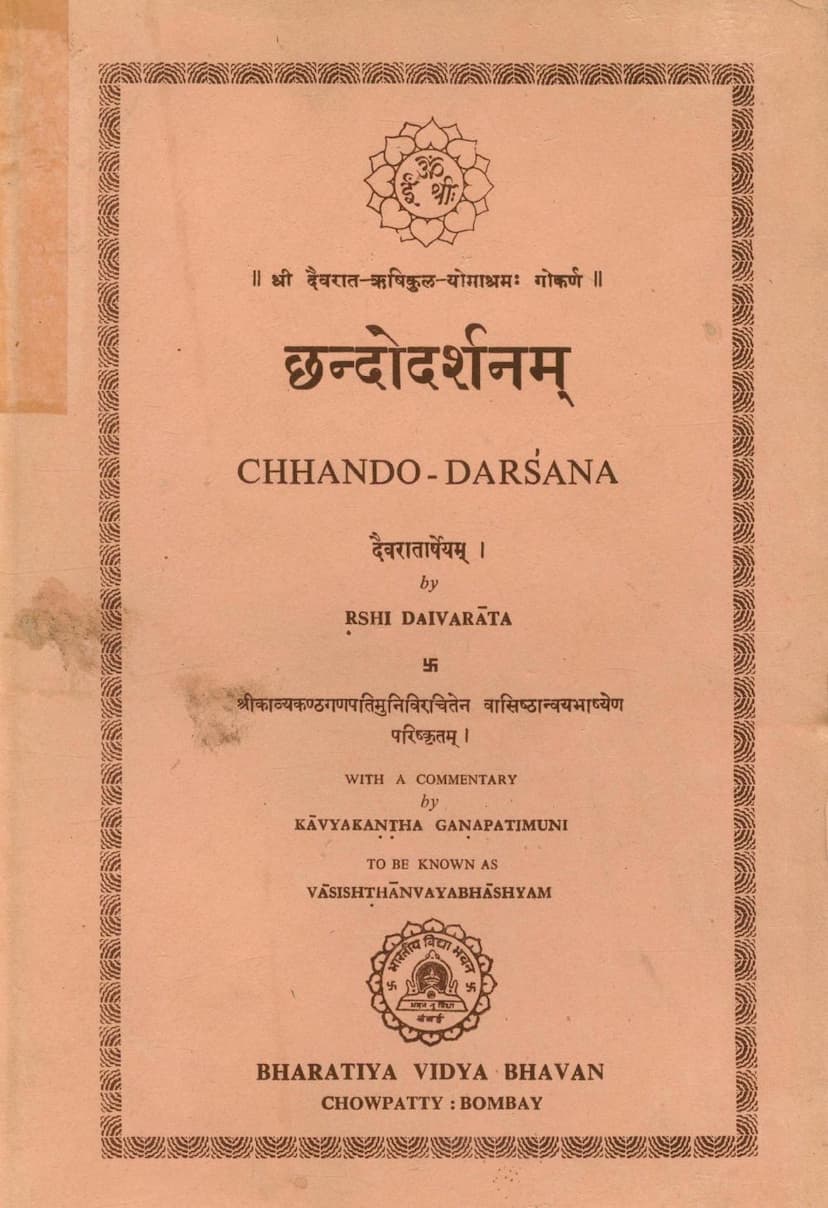Chandodarshanam
Added to library: September 1, 2025

Summary
Here's a comprehensive summary of the Jain text "Chandodarshanam," based on the provided text:
Title: Chhando-Darśana (छन्दोदर्शनम्) Author: Rishi Daivarāta (दैवरातार्षेयम्) Commentary: Vasishtanvayabhashyam by Kavyakantha Ganapati Muni (श्रीकाव्यकण्ठगणपतिमुनिविरचितेन वासिष्ठान्वयभाष्येण परिष्कृतम्) Publisher: Bharatiya Vidya Bhavan Publication Year: 1968 (First Edition)
Core Concept: Chhando-Darśana is a collection of newly revealed Vedic mantras in Sanskrit, believed to have been directly perceived by Rishi Daivarata in a state of yogic trance. The work is significant because it suggests that the revelation of Veda mantras, a process thought to have ceased centuries ago, is still possible today through intense austerity (tapas) and deep spiritual communion. Kavyakantha Ganapati Muni, recognizing the profound philosophical and poetic value of these mantras, wrote a detailed commentary called "Vasishtanvayabhashyam" to elucidate their meaning.
The Revelation of Chhando-Darśana: The book describes the divine revelation of new Vedic mantras to Rishi Daivarata. In 1917, while Daivarata was performing severe austerities with his Guru, Kavyakantha Ganapati Muni, near Shri Renukamba, he entered a state of Samadhi. During this state, words began to emerge from his lips. His Guru observed this for two days and realized it was Rigvedic metrical expression. For several days, until the process stopped, the Guru diligently transcribed the mantras. The collection was later organized into eight sections (Anuvakas) and named "Chhando-Darśana."
Thematic Content and Significance:
- Poetry and Philosophy: The "Chhando-Darśana" is not merely eulogistic but is described as having high poetry, penetrating philosophical thought, and being deeply inspiring.
- Unity and Artistic Arrangement: The mantras are characterized by their unitive thought, logical sequence, and artistic arrangement of hymns and sections.
- Vigour of Language: The language is noted for its vigor and contagious force.
- Cosmic Deities: The mantras speak of cosmic gods and goddesses like Indra, Sarasvati, and Brahmanaspati, reflecting grand conceptions.
- Modern Revelation: The work is presented as proof that the inspiration that worked in the great Rishis of the past is still alive and can manifest in modern times, challenging skepticism about the possibility of Mantra-Darśana in the present era.
The Commentary (Vasishtanvayabhashyam): Kavyakantha Ganapati Muni's commentary is described as profound, full-fledged, and rich in exposition. It aims to explain the meaning of the newly revealed mantras, ensuring they align with Vedic principles. The commentary emphasizes the authority of the Vedas as self-evident and the direct means of knowing ultimate reality, obtained through the Rṣhis' creative efforts (tapas) and inner vision. It connects the concept of Mantra-Darśana with the possibility of Brahma-Darśana, asserting that if the latter is possible, then the former, which leads to it, must also be possible.
Author and Guru:
- Rishi Daivarata: Described as a tapasvin (one who performs austerities), a yogi, a knower of spiritual truths, and a seer of Vedic mantras. He is also noted for his childlike nature, vigor, enthusiasm, and ongoing research in Vedic lore. Despite his lack of formal English education, he possesses mastery over the four Vedas and eloquent interpretation of Vedic literature. He can compose poetry in Sanskrit and speak several Indian languages.
- Kavyakantha Ganapati Muni: A versatile genius, disciple of Ramana Maharshi, and a profound Sanskrit scholar and poet. He recognized the significance of Daivarata's revelation and provided the essential commentary.
The Textual Structure: The book is structured into eight Anuvakas, each containing several Suktas (hymns) dedicated to specific deities or concepts. The initial Anuvakas focus on:
- Anuvaka 1: Deities like Savita, Agni, Indra, Vayu, Rudra, and Brahmanaspati, exploring their cosmic roles and attributes.
- Anuvaka 2: Sarasvati, extolling her as the divine source of speech, knowledge, and the universe.
- Anuvaka 3: Brahmanaspati, detailing his role as the lord of mantras, the creator, and the ultimate reality.
- Anuvaka 4: Indra, describing his power, pervasiveness, and role in creation and sustenance.
- Anuvaka 5: Atmā, the inner soul, detailing its omnipresence, immortality, and connection with the Supreme.
- Anuvaka 6: Purusha, the Supreme Being, described as the origin, pervader, and ultimate reality.
- Anuvaka 7: Apah (Waters), highlighting their divine nature, purity, and life-giving properties, and their connection to various deities.
- Anuvaka 8: Go (Cow) and Visvedevas (All Gods), exploring the sacredness of the cow and acknowledging the interconnectedness of various deities.
Key Philosophical Underpinnings:
- Mantra-Darśana: The central theme is the possibility of direct perception of Vedic mantras in modern times through tapas.
- Sabda-Brahma: The Veda and its mantras are seen as Sabda-Brahma, the creative sound principle.
- Unity of Existence: The mantras emphasize the unitive thought of the cosmic gods and goddesses, reflecting a deep philosophical understanding of the universe.
- Tapas and Sadhana: The text highlights the importance of severe austerities, disciplined practices (sadhana), devotion to the Guru, and faith as means to achieve spiritual realization and Mantra-Darśana.
- The Seer's Perspective: Daivarata's childlike nature, profound surrender to his Guru, and his ability to channel divine inspiration are crucial to understanding the revelation.
In essence, "Chhando-Darśana" presents a modern revelation of Vedic wisdom, demonstrating the enduring possibility of spiritual insight through dedicated practice and emphasizing the profound, philosophical, and artistic nature of these new mantras, supported by a masterly commentary.